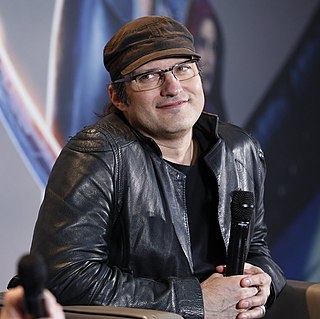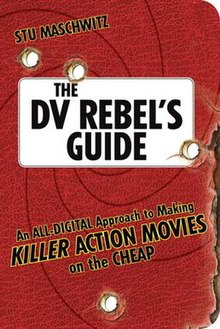
Film editing is both a creative and a technical part of the post-production process of filmmaking. The term is derived from the traditional process of working with film which increasingly involves the use of digital technology.

Robert Anthony Rodriguez is an American filmmaker and visual effects supervisor. He shoots, edits, produces, and scores many of his films in Mexico and in his home state of Texas. Rodriguez directed the 1992 action film El Mariachi, which was a commercial success after grossing $2 million against a budget of $7,000. The film spawned two sequels known collectively as the Mexico Trilogy: Desperado and Once Upon a Time in Mexico. He directed From Dusk Till Dawn in 1996 and developed its television adaptation series (2014–2016). Rodriguez co-directed the 2005 neo-noir crime thriller anthology Sin City and the 2014 sequel, Sin City: A Dame to Kill For. Rodriguez also directed the Spy Kids films, The Faculty, The Adventures of Sharkboy and Lavagirl, Planet Terror, Machete, and Alita: Battle Angel. He is the best friend and frequent collaborator of filmmaker Quentin Tarantino, who founded the production company A Band Apart, of which Rodriguez was a member. In December 2013, Rodriguez launched his own cable television channel, El Rey.
Visual effects is the process by which imagery is created or manipulated outside the context of a live action shot in filmmaking. The integration of live action footage and CG elements to create realistic imagery is called VFX.
Filmmaking is the process of making a film, generally in the sense of films intended for extensive theatrical exhibition. Filmmaking involves a number of complex and discrete stages including an initial story, idea, or commission, through screenwriting, casting, shooting, sound recording and pre-production, editing, and screening the finished product before an audience that may result in a film release and an exhibition. Filmmaking takes place in many places around the world in a range of economic, social, and political contexts, and using a variety of technologies and cinematic techniques.
In filmmaking, a pitch is a concise verbal presentation of an idea for a film or TV series generally made by a screenwriter or film director to a film producer or studio executive in the hope of attracting development finance to pay for the writing of a screenplay.
Film-out is the process in the computer graphics, video production and filmmaking disciplines of transferring images or animation from videotape or digital files to a traditional film print. "Film-out" is a broad term that encompasses the conversion of frame rates, color correction, as well as the actual printing, also called scanning or recording.
Motion graphic design is a subset of graphic design in that it uses graphic design principles in a filmmaking or video production context through the use of animation or filmic techniques. Examples include the kinetic typography and graphics used in film and television opening sequences, and the spinning, three-dimensional station identification logos of some television channels. The art form has been around for decades, and has advanced in technical sophistication over time.
Stuart T. Maschwitz, commonly known as Stu Maschwitz, was the co-founder and chief technology officer of The Orphanage, a visual effects company that was based in California. He has worked as senior visual effects supervisor on several films. He previously worked at Industrial Light and Magic.
The Orphanage was a visual effects studio located in California. It had offices in Los Angeles and San Francisco. It was co-founded in 1999 by Stu Maschwitz, Jonathan Rothbart, and Scott Stewart, who all previously worked at Industrial Light & Magic. Scott Kirsner at Hollywood Reporter interviewed a couple of the founders, and writes about the company and its plans. Stu Maschwitz created the Magic Bullet software which gives video a film look, and wrote a book about guerrilla filmmaking called The DV Rebel's Guide: An All-Digital Approach to Making Killer Action Movies on the Cheap.

Rebel Without a Crew is a 1995 non-fiction book by Robert Rodriguez. Presented in a diary format, Rebel details Rodriguez's beginnings as a young filmmaker, his stint at a medical testing facility to raise money for a feature film, the making of that film for $7,000, and his subsequent experiences in Hollywood selling the film and going to film festivals promoting it.

405 is a three-minute film released in June 2000. It was produced by Bruce Branit and Jeremy Hunt on a US$300 budget, using significantly self-taught skills with personal computers. 405 is also one of the earliest viral videos. It immediately became notable as an early example of the revolution in digital filmmaking and the use of broadband Internet as a channel to distribute media, and the results rival that of many major film and television production studios at the time.
Guerrilla filmmaking refers to a form of independent filmmaking characterized by low budgets, skeleton crews, and simple props using whatever is available. Often scenes are shot quickly in real locations without any warning, and without obtaining filming permits.
In filmmaking, the rough cut is the second of three stages of offline editing. The term originates from the early days of filmmaking when film stock was physically cut and reassembled, but is still used to describe projects that are recorded and edited digitally.
Previsualization is the visualizing of complex scenes in a movie before filming. It is also a concept in still photography. Previsualization is used to describe techniques such as storyboarding, either in the form of charcoal sketches or in digital technology, in the planning and conceptualization of movie scenes.

Film, also called movie, motion picture or moving picture, is a visual art-form used to simulate experiences that communicate ideas, stories, perceptions, feelings, beauty, or atmosphere through the use of moving images. These images are generally accompanied by sound, and more rarely, other sensory stimulations. The word "cinema", short for cinematography, is often used to refer to filmmaking and the film industry, and to the art form that is the result of it.
Microfilmmaking is the production of ultra-low budget movies. These films generally are made by impassioned filmmakers operating outside the Hollywood mainstream. While a "low budget" Hollywood film can cost millions of dollars, 80% to 90% of all independent films are made for budgets of $30,000 or less.

Craig Tanner is an American film director, film producer, and editor. He is best known for his work as visual effects editor for the film Avatar and as producer and editor of God Sleeps in Rwanda. Tanner is also the co-founder of Digital Revolution Studios, a 3D production studio.
GenArts, Inc. is a Cambridge, Massachusetts-based developer of visual effects software for the film, broadcast and advertising industries. A majority of traditional video content such as movies, commercials, television shows, newscasts and music videos include at least some special effects created in a GenArts product. GenArts create visual effects software and plugins that integrate visual effects such as glows, lightning, fire and fluids into post-production video editing software from companies like Apple, Adobe, Autodesk and The Foundry.
The term "microcinema" can have two meanings. It can describe low-budget or amateur films shot mostly on digital video, edited on a computer, and then distributed via videotape, disc or over the Internet. Or it can describe a mode of low-budget exhibition—a small theater or screening series operated in order to show small-gauge filmmaking, artists works, shorts, and repertory programming.

Producing Great Sound for Film and Video: Expert Tips from Preproduction to Final Mix is a non-fiction book and filmmaking handbook. The book is also used as a university textbook. It covers the process of acquiring professional quality sound for motion picture productions.






